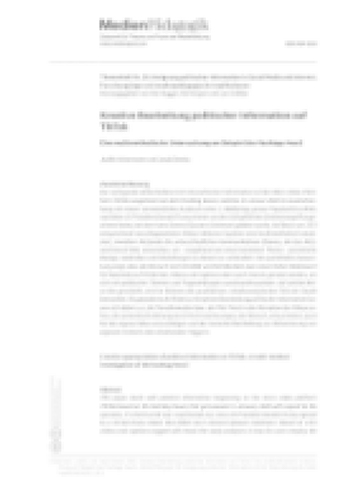Abstract
This article describes and investigates an approach to improving knowledge transfer in industrial environments by means of Mixed-Reality (MR) technology. With the advent of the internet of things, cyber physical systems and related technological progress cause work related conditions, requirements and processes to change fast. Due to this, it is ever more important for employees to deepen their transferable skills and to transfer technical know-how. We will discuss the idea of easing the transfer of complex skills via a learning setting that combines didactical elements with the use of MR technology. Via employing MR, it is possible to offer information to the students just in the moment they need it to perform a recurrent skill (van Merriënboer and Kirschner, 2013). The working environment can be augmented with information explaining how problems can be solved. Offering this know-how directly inside of in the industrial environment (via MR) can ease the transfer of knowledge (Dunleavy and Dede, 2014; Wu et al. 2013). After giving a definition of the problem and an introduction to MR, we present a concept of how a learning setting can help to increase motivation and reduce the effort of learning transferable know-how. We show how this setting should be designed and evaluated and how to apply the results to similar contexts.References
Adolph, Lars, Isabel Rothe, und Armin Windel. 2016. «Arbeit in der digitalen Welt – Mensch im Mittelpunkt». Zeitschrift für Arbeitswissenschaft 70, 2:77–81.
Bacca, Jorge, Silvia Baldiris, Ramon Fabregat, Sabine Graf, und Kinshuk. 2014. «Augmented Reality Trends in Education: A Systematic Review of Research and Applications». Journal of Educational Technology & Society 17, 4:133–149.
bayme vbm Studie. 2016. Industrie 4.0 – Auswirkungen auf Aus- und Weiterbildung in der M+E Industrie, Universität Bremen: vbm.
Brown, Ann L. 1992. «Design experiments: Theoretical and methodological challenges in creating complex interventions in classroom settings». The Journal of the Learning Sciences 2, 2:141–178.
Cheng, Kun-Hung, und Chin-Chun Tsai. 2013. «Affordances of augmented reality in science learning. Suggestions for future research». Journal of Science Education and Technology 22, 4:449–462.
Dunleavy, Matt, und Chris Dede. 2014. «Augmented reality teaching and learning.» In Handbook of research on educational communications and technology, herausgegeben von J. Michael Spector, M. David Merrill, Jan Elen, und M. J. Bishop, 735–745. New York: Springer.
Hochberg, Jana. 2012. Das Verhältnis der Wirklichkeitsbereiche: Online - Offline: Was ist virtuell, was ist Realität. Saarbrücken: AV Akademikerverlag.
Ifenthaler, Dirk, und Deniz Eseryel. 2013. «Facilitating complex learning by mobile augmented reality learning environments.» In Reshaping Learning, herausgegeben von Ronghuai Huang, Kinshuk, und J. Michael Spector, 415–438. Berlin Heidelberg: Springer.
McKenney, Susann, und Thomas C. Reeves. 2014. «Educational design research.» In Spector, Handbook of Research on Educational Communications and Technology, herausgegeben von David M. Merrill und Jan Elen, 4th. New York: Lawrence Erlbaum Associates.
Merriënboer, Jeroen J. G. van, und Paul A. Kirschner. 2012. Ten Steps to Complex Learning: A Systematic Approach to Four-Component Instructional Design (2 edition). New York: Routledge.
Milgram, Paul, Haruko Takemura, Akira Utsumi, und Fumio Kishino. 1994. «Augmented Reality: A class of displays on the reality-virtuality continuum.» Telemanipulator and Telepresence Technologies SPIE 2351, 282–292.
Nonaka, Ikujiro, und Hirotaka Tekeuchi. 2012. Die Organisation des Wissens. Wie japanische Unternehmen eine brachliegende Ressource nutzbar machen. Frankfurt/New York: Campus Verlag.
O'Shea, Patrick, und Jennifer Elliot. 2015. «Augmented reality in education: an exploration and analysis of paedagogical design in mobile augmented reality applications». In Proceedings of Society for Information Technology & Teacher Education International Conference 2015, herausgegeben von David Rutledge und David Slykhuis, 3525-3532. Chespeake, VA: Association for the Advancement of Computing in Education (AACE).
Reinmann, Gabi. 2005. «Innovation ohne Forschung? Ein Plädoyer für den Design-Based Research-Ansatz in der Lehr-Lernforschung». Unterrichtswissenschaft 33, 1:52–69.
Sendler, Ulrich. 2013. Industrie 4.0. Beherrschung der industriellen Komplexität mit SysLM. Berlin / Heidelberg: Springer.
Pfeiffer, Sabine, und Anne Suphan. 2015. Der AV-Index. Lebendiges Arbeitsvermögen und Erfahrung als Ressourcen auf dem Weg zur Industrie 4.0. Working Paper 2015 #1, Universität Hohenheim, https://www.sabine-pfeiffer.de/files/downloads/2015-Pfeiffer-Suphan-draft.pdf.
Wu, Hsin-Kai, Silvia Wen-Yu Lee, Hsin-Yi Chang, und Jyh-Chon Liang. 2013. «Current status, opportunities and challenges of augmented reality in education.» Computers & Education 62, 41–49.

